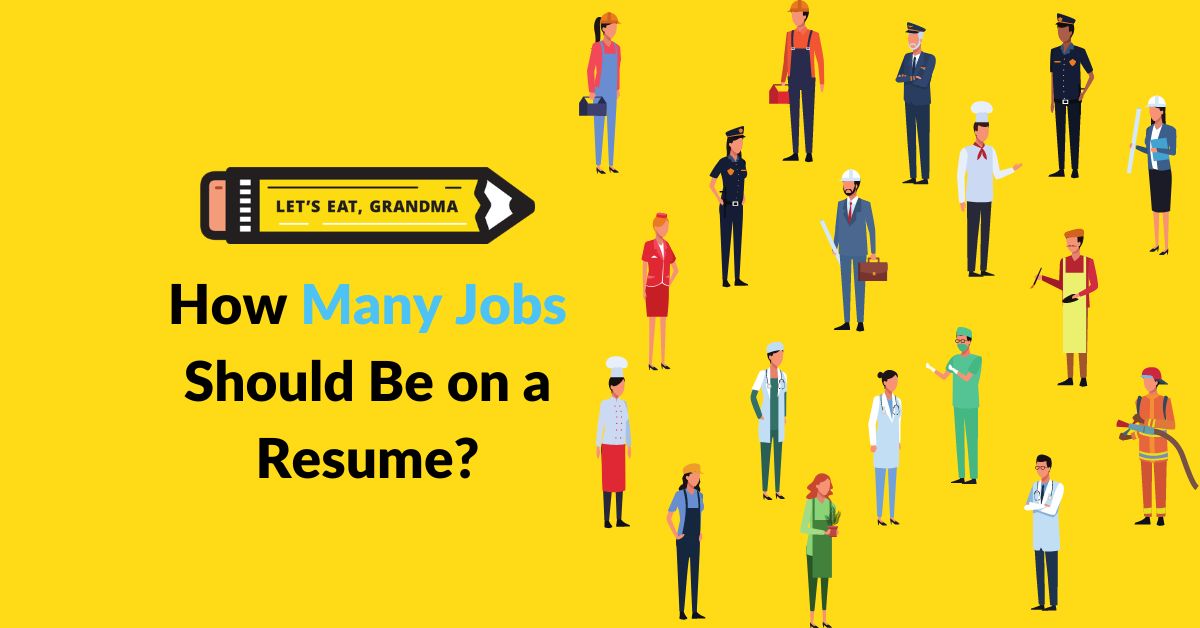How Many Jobs Should Be on a Resume?

Had a lot of jobs and wondering how many you need to list on your resume? Instead of looking for a hard-and-fast number, read these guidelines based on relevance.
Editor’s note: This post was originally published in 2020; it has been updated for accuracy and comprehensiveness.
By: Matt Dupee | Contributing Writer for Let’s Eat, Grandma
As a resume writer, I get asked a lot of tricky questions.
One that folks always struggle with and I get asked almost every day is, “how far back should a resume go?”
While most job seekers know that recent experience is most important, many still think they should pad their resume with older jobs to show more experience. Some folks with two-page resumes even just want to fill white space when they don’t quite fill the last half of page two.
Want more job search tips? Sign up for our newsletter!
Recency and Relevance: The two most important considerations for determining what to include on your resume
Like most things on your resume, there is no one, hard-and-fast rule on how far back your resume should go, or how many jobs you should include.
Every resume is based on the job search it represents, and every job search is different. Tailoring your resume is the most important factor.
Rather than thinking about a year limit, or a quota or limit of jobs to include, you should consider two factors when building your resume.
1. Recency
Hiring managers are more concerned with your most recent positions than seeing all the details of a lengthy career history. If you have plenty of recent, relevant work experience, there’s no reason to crowd your resume with older positions, even if they’re also related to the job description. You should very seriously consider not listing your jobs that are 15-20 years old. Will that role you held back in the 90s influence your next role? The answer is almost always no, especially if you’re in a quickly changing field like technology.
The truth is that older jobs often don’t tell an employer much about your current skillset, especially when it comes to software, methodologies, and terminology. Age discrimination is alive and well in the hiring process. Including older jobs can reveal your age and give employers a reason to skip over your resume in the initial screening process.
2. Relevance
Focus on including jobs that are most relevant to the position you’re applying for. If you have a long work history, you don’t necessarily need to list every job you’ve ever had. Instead, prioritize those that showcase skills, experiences, and accomplishments that are directly related to the job you’re pursuing. Highlight your relevant experience, so it stands out.
Always remember that hiring managers and recruiters will quickly scan your resume for relevant details. Even if you want to show the depth of your experience, making your resume longer and more wordy is not the way to do so. You can call out interesting but less-relevant information in your cover letter or LinkedIn profile, if you want.
Not sure your resume effectively highlights all your relevant experience? Send it to us for a free critique!

Photo by TheStandingDesk on Unsplash
Other considerations for determining how many jobs to include on your resume
Presenting older relevant experience
Let’s say you have had a mixed career path, like many modern professionals. What if you held a job back in 2000 that’s super relevant to the job you’re applying to now? Or what if you’re changing careers again, and that old job is the most relevant experience you have for your upcoming change?
In these cases, you should list the old job because it’s relevant.
If you have a long work history but only a few jobs are directly related to the position you’re applying for, you can create a “Relevant Experience” section to highlight those specific jobs. This way, you can provide a concise overview of your most important experience.
If you have a lot of recent experience that is relevant to the job description, and a few older relevant accomplishments, you can consider an Early Career or Additional Experience section after your Professional Experience section. Then you can reduce the information you include in this section to shorter entries, and even take off the dates, so the focus is on your accomplishments and not the time frame.
Avoiding looking like a “Job Hopper”
If you held multiple roles lasting one to two years each, it pays to be ruthless when determining relevancy and recency of each position.
If you’ve held jobs that are completely unrelated to the position you’re applying for and they don’t add any value to your application, you may choose to leave them off your resume. Likewise, omitting jobs from over 15 years ago can tighten up your experience.
If you’ve done freelance or contract work, you can include it in a separate section or grouped together under a heading like “Freelance/Contract Work” to highlight your versatility and additional experience.
If excluding certain jobs leaves noticeable employment gaps on your resume, consider addressing those gaps in your cover letter, your LinkedIn profile, or during the interview.
Tailoring your resume
Now more than ever, a tailored resume remains an indispensable tool for job seekers navigating an increasingly competitive and dynamic job market. As technology such as Applicant Tracking Systems continues to shape the recruitment process and employers receive a deluge of applications for each open position, a customized resume stands out as a critical means of making a memorable first impression.
This means you may need to reorganize your resume or take off positions that aren’t relevant to your goals, so you can highlight the information that is. By meticulously tailoring your resume to each position, you demonstrate a deep understanding of the employer’s needs and a genuine interest in the role. This not only captures the attention of hiring managers but also increases your chances of passing through the ATS that many companies use to filter resumes.
A tailored resume underscores your adaptability and attention to detail, qualities highly valued by employers in a rapidly evolving job market. It reflects your ability to analyze job descriptions, identify key skills and qualifications, and present your background in a way that resonates with the hiring team.
Prioritizing readability
Keep in mind that a resume should ideally be no longer than one or two pages. Including too many jobs can make your resume cluttered and less readable. No matter how diligent a hiring manager or recruiter is, they will likely not spend much time reading your resume. Prioritize brevity and clarity.
If you’re on the fence about whether or not to include an older job, think about your resume length in general as well. If your older jobs are pushing the resume onto an extra page, take them out! Especially if they’re spilling onto a third page — that’s a no-brainer.
Remember: It’s crucial that your resume is clear, concise, and targeted. You can always list those “on the fence” jobs on LinkedIn if you really feel you need to.
Not sure your resume effectively highlights all your relevant experience? Send it to us for a free critique!

Photo by Christina @ wocintechchat.com on Unsplash
Addressing omissions
OK, OK, so you’ve made the hard cuts. Is there anywhere to showcase the things that didn’t make it in your resume, but you’re still proud of?
- Cover Letter: Your cover letter is an ideal place to provide context for any gaps in your employment history or to mention qualifications that didn’t make it onto your resume. Be concise and focus on explaining why you’re a strong candidate despite these gaps or additional information. Emphasize how your skills and experiences align with the job requirements.
- Online Profiles: If you have a LinkedIn profile or an online portfolio, you can include more comprehensive information about your work history, skills, and accomplishments that didn’t make it onto your resume. Employers often review candidates’ online profiles, so this can be a way to provide additional context.
- Interview: The purpose of a resume is to get you an interview. During the interview, you can elaborate on any aspects of your background that weren’t included on your resume. This is an opportunity to discuss employment gaps, personal projects, freelance work, or any other relevant experiences that you couldn’t fit into your resume. Be prepared to answer questions about these aspects and highlight how they’ve contributed to your skills and qualifications.
The Bottom Line
Ultimately, the goal is to create a resume that effectively communicates your qualifications and suitability for the specific job you’re seeking. There’s no hard- and-fast rule for how many jobs to include on your resume — focus on recency and relevance and you’ll be on your way to a tailored resume that shows how you match the needs of the employer and emphasizes the most relevant and impressive aspects of your work history.
Wondering how your resume stacks up? Request a free resume critique!
Better Resume.
Satisfying Career.
Happier You.

